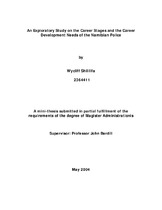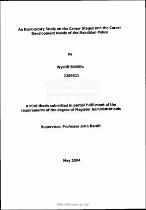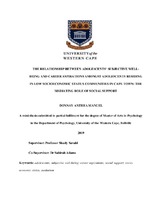| dc.description.abstract | Research indicates that approximately fifteen years ago there were over three (3) million dualcareer couples representing 20% of dual-worker couples. It is expected that the amount of dual-career couples will continue to increase, as most college students, both men and women, anticipate participating in a career as well as in a family (Spiker- Miller & Kees, 1995).Individuals and organizations are confronted with a hyper turbulent environment and individuals are also faced with a myriad of challenges and adversity in their work and personal lives. Due to the economy and the changing needs of individuals, today very few families reflect the configuration of a typical family (a husband who worked outside the home, a wife who fulfilled the duties of homemaker and child-carer), as both partners are normally employed. The dual-career couple phenomenon has added to the pressure of
managing multiple demands and has a considerable impact on the nature of people's careers(Greenberg & Baron, 2003). Dual-career couples‘ career advancement is largely affected by the career barriers they perceive to encounter. The perceptions of career barriers encountered differ from one couple to another based on factors such as: age, race and parental demand(children). Differences may also exist between partners in a dual-career relationship based on their gender.Most studies that have been conducted have looked at work-life balance of dual-career couples or have focused on the problems dual-career couples face solely from the woman‘s perspective. The aim of this study is to look at dual-career couples not only from female‘s perspective and to tap into their perceptions regarding career barriers encountered in the workplace. The findings could help organisations realize the importance of assisting dualcareer couples and how they could improve their career development. Dual-career couples therefore warrant attention as a special group seeing as the career salience, strategies and transitions of one partner inevitably affects those of the other, which could also have repercussions for their employers (Smith, 1997).A self-developed Demographic Questionnaire and the Career Barriers Inventory (Revised) was used to gather the data. The research was conducted within a large retail organisation.
The sample comprised of men and women, permanent and contract employees within the following departments: Human Resources, Marketing, Logistics, Finance, Group Merchandise Procurement (GMP), Buying, Sourcing, Audit, Planning and Group Services.The sampling procedure that was utilised was non-probability sampling. Statistical analyses involved descriptive statistics (Frequencies, Means and Standard deviations) and inferential statistics (T-Test and Analysis of variance).
The study revealed that the most highly rated career barriers which respondents perceived to experience or which affected their career advancement were multiple-role conflict, decisionmaking difficulties, sex discrimination and racial discrimination. Whilst, the career barriers which were rated the lowest by respondents included disapproval by significant others, disability/health concerns and discouraged from choosing non-traditional careers.Furthermore, the findings indicated that the perceptions of dual-career couples based on gender regarding career barriers in the workplace is partially accepted because there are statistically significant differences regarding the perceptions amongst females and males in
terms of lack of confidence as a career barrier. The hypothesis proposing that there are significant differences in the perceptions of dual-career couples who have and those who do not have children, is partially accepted, as there was a statistically significant difference regarding disapproval by significant others. The findings for the perceptions of dual-career couples based on race regarding career barriers in the workplace is partially supported because significant differences were found for the following career barriers: difficulties with network/socialisation, lack of confidence and race discrimination based on employees‘ race.Lastly, significant differences in the perceptions of dual-career couples based on age regarding career barriers in the workplace was rejected, as no significant differences regarding career barriers based on employees‘ age were found.Amongst others, a limitation of this study is evident. The study may lack generisability as the
sampling procedure used was non-probability sampling and only included those employees who were easily accessible. Additionally, a quantitative study was used by making use of questionnaires, but no observation or interviews were used. The present study also only focuses on the differences in perceptions of dual-career couples, based on biographical factors such as; gender, age, number of children (parental demands), race and age. Ideally all research should have a broad speck of people or participants, to ensure higher generalizability.In an effort to deal with the limitations of the current study, the following are recommended, future research should use a large proportionate stratified random sample as this would allow the findings to be reliably generalised to the population. A combination of both quantitative and qualitative methodology would help to develop detailed understanding of dual-career couple‘s and their differences in perceptions of career barriers.It is important for organisations to have continuous negotiations with employees in order to integrate the demands of the organisation and the career needs of its employees. Furthermore,they should respond to the shifting demographics by adopting voluntary policies such as alternative work schedules and child and elder care assistance to help workers meet family needs, which in turn will be beneficial to the organisation by attracting and retaining the best
talent. | en_US |




